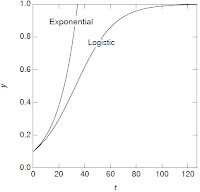 |
| Fig. 2.16 from IPMB. A plot of the solution of the logistic equation when y0 = 0.1, y∞ = 1.0, b0 = 0.0667. Exponential growth with the same values of y0 and b0 is also shown. |
Sometimes a growing population will level off at some constant value. Other times the population will grow and then crash. One model that exhibits leveling off is the logistic model, described by the differential equationBelow is a new homework problem, analyzing the logistic equation in a way to build insight. Consider it an early Christmas present. Santa won’t give you the answer, so you need to solve the problem yourself to gain anything from this post.
dy/dt = b0 y (1 – y/y∞) , (2.28)
where b0 and y∞ are constants….
If the initial value of y is y0, the solution of Eq. 2.28 is
y(t) = 1 / [1/y∞ + (1/y0 – 1/y∞) e−b0t] . (2.29)
Section 2.10
Problem 36 ½. Consider the logistic model.
(a) Write Eq. 2.28 in terms of dimensionless variables Y and T, where Y = y/y∞ and T = b0t.
(b) Express the solution Eq. 2.29 in terms of Y, T, and Y0 = y0/y∞.
(c) Verify that your solution in part (b) obeys the differential equation you derive in part (a).
(d) Verify that your solution in part (b) is equal to Y0 at T = 0.
(e) In a plot of Y(T) versus T, which of the three constants (y∞, y0, and b0) affect the qualitative shape of the solution, and which just scale the Y and T axes?
(f) Verify that your solution in part (b) approaches 1 as T goes to infinity.
(g) Find an expression for the slope of the curve Y = Y(T). What is the slope at time T = 0? For what value of Y0 is the initial slope largest? For what values of Y0 is the slope small?
(h) The plot in Fig. 2.16 compares the solution of logistic equation with the exponential Y = Y0 eT. The figure gives the impression that the exponential is a good approximation to the logistic curve at small times. Do the two curves have the same value at T = 0? Do the two curves have the same slope at T = 0?
(i) Sketch plots of Y versus T for Y0 = 0.0001, 0.001, 0.01, and 0.1.
(j) Rewrite the solution from part (b), Y = Y(T), using the constant T0, where T0 = ln[(1−Y0)/Y0]. Show that varying Y0 is equivalent to shifting the solution along the T axis. What value of Y0 corresponds to T0 = 0?
(k) How does the logistic curve behave if Y0 > 1? Sketch a plot of Y versus T for Y0 =1.5.
(l) How does the logistic curve behave if Y0 < 0? Sketch a plot of Y versus T for Y0 = –0.5.
(m) Plot Y versus T for Y0 = 0.1 on semilog graph paper.
If you solve this new homework problem and want to compare you solution to mine, email me at roth@oakland.edu and I’ll send you my solution.
The Logistic Equation, MIT OpenCourseWare



No comments:
Post a Comment